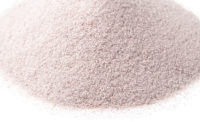Silica, often referred to as quartz, is a common mineral. It is found in many materials common on construction sites, including soil, sand, concrete, masonry, rock, granite, and landscaping materials.1
If you’re in construction, maritime, hydraulic fracturing, or other general industries using silica, the new silica standard and silica dust should matter to you. Chances are, you could be getting exposed to dangerous respirable silica dust that you can’t even see. And, what you can’t see, can hurt you.
In fact, OSHA estimates that roughly 2.3 million people in the U.S. are exposed to silica at work. Health effects range from incurable lung disease to death, and therefore warrant significant attention from workers and employers alike.
Exposure scenarios
Dust created by cutting, grinding, drilling, blasting or otherwise disturbing silica materials can contain crystalline silica particles. These particles are small and invisible to the human eye. When these tiny silica dust shards are inhaled, they often become imbedded deep into the alveolar sacs of the lungs (where oxygen and carbon dioxide are exchanged).
Unfortunately, respirable silica dust can be hazardous and can cause silicosis, the oldest industrial disease. As silicosis progresses, shortness of breath begins to occur and clinical tests will reveal a poor exchange of oxygen and carbon dioxide. In later stages patients may experience persistent coughing, fatigue, extreme shortness of breath and even complete respiratory failure.
Okay, enough of the bad news. What’s being done about it?
Here’s some good news: While silicosis is progressive, irreversible and incurable, NIOSH and OSHA have taken the position that silicosis is completely preventable.
With more than a million individuals affected, it’s no wonder that OSHA rolled out new respirable crystalline silica standards focused on limiting worker exposure to respirable crystalline silica.
Put briefly, OSHA’s new silica dust standard limits exposure to the tune of 50 micrograms of respirable crystalline silica per cubic meter of air, averaged over an eight-hour day. Still have no idea what that means? Here’s a tangible comparison, “50 micrograms has roughly the same mass as a fly’s wing.”2
So, here’s the deal: 50 micrograms is not much. You want to stay in compliance and keep exposure at safe levels. To help keep you and your workers safe and happy, we reviewed tips and best practices for reducing silica dust exposure. Here are three steps that you can take to get the ball rolling on a Silica Dust Plan.
Step one
Conduct a risk assessment to determine whether or not your workers could reasonably be exposed to the action level of 25 μg/m3 (micrograms of silica per cubic meter of air), averaged over an eight-hour day.
Ask yourself: Is there silica on site that could potentially be released into the air? Don’t limit this question to the use of raw material. Keep in mind any activities on a silica substrate, like crushing, chipping, and blasting to name a few.
Don’t just guess. Utilize air monitoring technology to confirm exposure rates. When air monitoring occurs, be sure to include measurement of tasks that create the highest potential exposure.
Step two
Establish and implement a written plan to protect workers from exposures over the PEL of 50 μg/m3, averaged across an 8-hour day.
To be compliant, this requires:
- Identifying tasks from your exposure assessment that could expose workers to silica dust.
- Outlining the engineering controls, work practices and respiratory protections methods used to limit exposure.
- Outlining the housekeeping measures and restricted work area procedures used to limit exposure.
- Designating a competent person to implement this plan.
- Using the data from your assessment, establish control methods, such as those laid out for the construction industry in OSHA’s Table 13. Or, independently decide upon alternative dust controls methods that will best limit exposure.
While engineering control methods vary greatly in efficacy depending on the task and the scenario, some potential methods to consider are:
- Containment - Create a dust containment system for the ongoing removal and filtration of contaminated air.
- Housekeeping - Restrict practices like dry brushing, dry sweeping, using compressed air without ventilation, etc., that expose workers to silica dust.
- Personal Protective Equipment (PPE) - Due to protective and practical limitations, the new OSHA Rule specifies that respiratory protection should only be used in cases where engineering controls are inadequate.4
- Restricted Areas - Wherever possible, prohibit workers from entering high risk dust exposure zones.
- Substitution - Avoid silica altogether by using alternate materials.
- Ventilation - Affix a local exhaust ventilation (LEV) unit directly to equipment to contain dust at the source of origin.
- Wet Methods - Use water or other liquid agents where appropriate to reduce the generation of dust.
Step three
Training is always an integral part of a successful health and safety plan. Prepare to train workers on:
- The health effects of silica exposure,
- Workplace tasks that can expose them to silica,
- Ways to limit exposure.
Ask yourself:
- Have workers received hazard training?
- If using LEVs, did specific control training include proper disposal techniques, control limitations, and proper maintenance of tools?
- If using wet methods do they know the amount of water to be used, how to apply the water, and length of time water should be applied?
- In sum, can employees demonstrate adequate knowledge of chosen controls or alternative protective measures?
Follow up is also required. Make sure that:
- Exposure levels are verified through air monitoring to confirm that controls are effective.
- Medical exams are offered every three years to workers who are required to wear a respirator 30+ days per year.
- Records are kept of all silica exposure and medical exams.
While these tips are by no means all encompassing, we do hope that this article serves to re-introduce the revised silica standard and give you the basic oversight to consider whether you are OSHA compliant and protect the long-term health of your fellow workers.
References
- Visit OSHA’s Silica Overview here: https://www.osha.gov/dsg/topics/silicacrystalline/
- Engineering Controls and Housekeeping Practices to Reduce Silica Dust Levels. Nilfisk. September 26, 2016. <http://news.nilfiskcfm.com/2016/09/engineering-controls-housekeeping-practices-reduce-silica-dust-levels/>. January 31, 2018.
- OSHA’s Table #1 of Specified Exposure Control Methods helps provide effective dust control methods to 18 common construction tasks. https://www.osha.gov/pls/oshaweb/owadisp.show_document?p_table=STANDARDS&p_id=1270
- For more information about OSHA’s stance on respiratory protection, see 29 CFR 1910.134: Respiratory Protection: https://www.osha.gov/pls/oshaweb/owadisp.show_document?p_table=standards&p_id=12716



